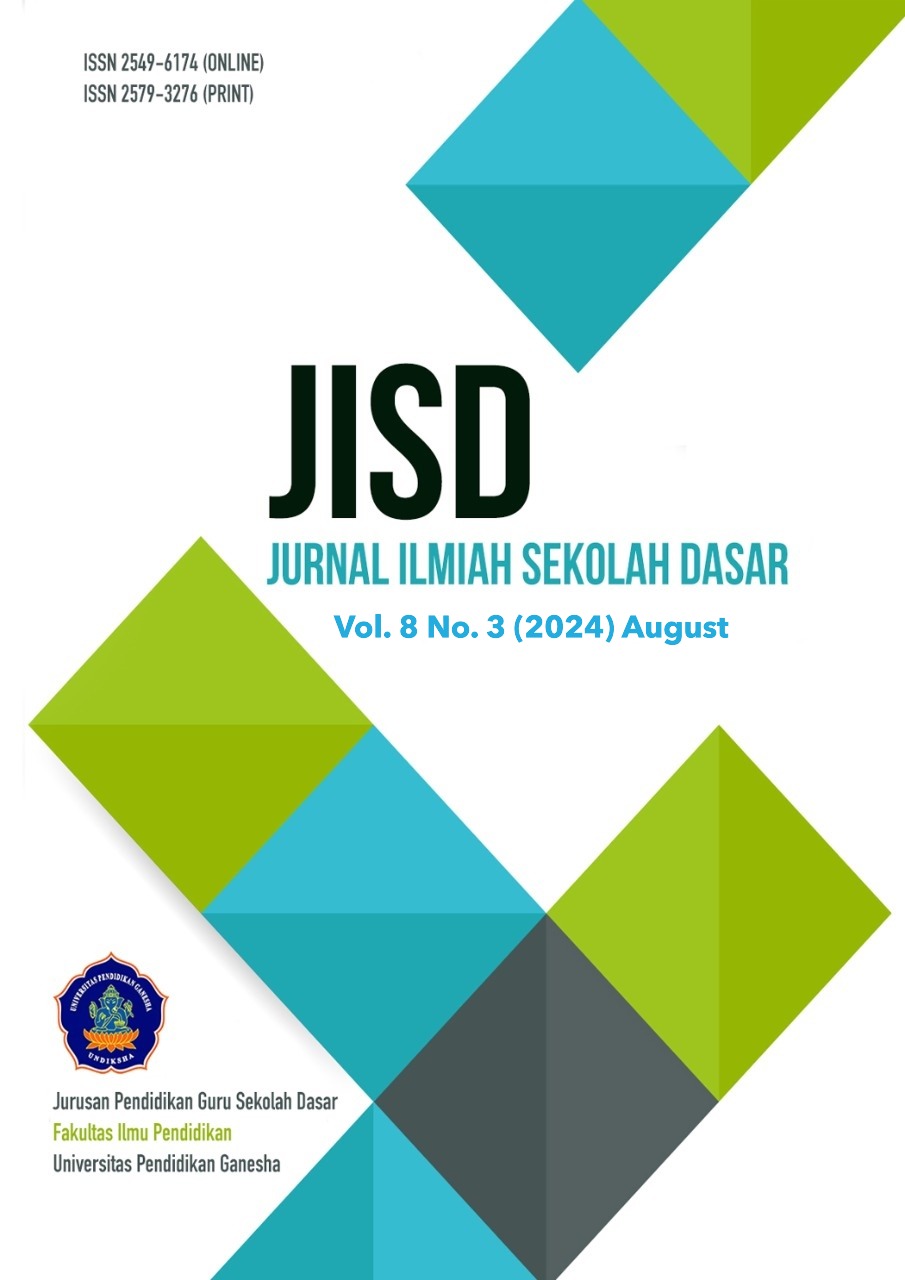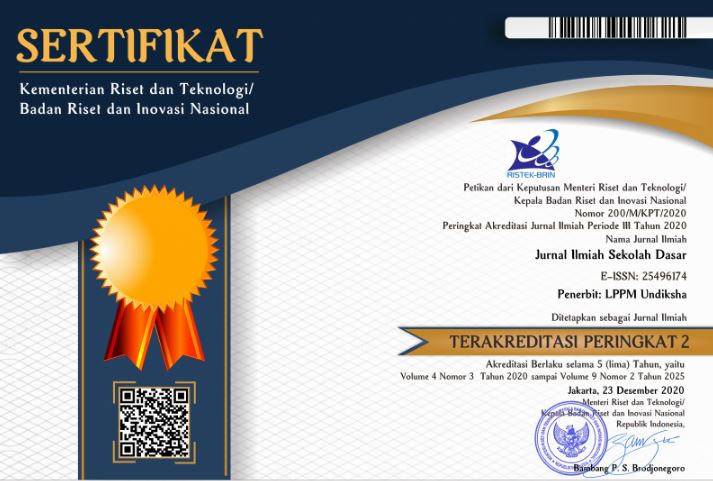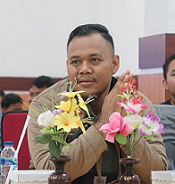The Reflective Reading Corner: Enhancing Literacy and Critical Thinking in Elementary Schools
DOI:
https://doi.org/10.23887/jisd.v8i3.77025Keywords:
Reflective Reading, Literacy, Critical ThinkingAbstract
One of the primary challenges in achieving equitable education quality at the elementary school level is students' low reading literacy skills. This study aims to analyze the effectiveness of reading corners in improving students' literacy and critical thinking skills. The research employed a qualitative design with data collected through interviews, observations, and documentation. The research instruments included tests and documentation. Data collection involved interviews with teachers and students, observations of reading corner activities, and documentation of literacy programs conducted by the school. Data analysis was carried out using thematic analysis to identify patterns and relevant categories. The findings revealed that reading corners effectively enhance students' literacy and critical thinking skills. Students who regularly visited the reading corner were more active in literacy activities, demonstrated higher reading interest, and showed improved critical thinking abilities during learning sessions. Teachers also played a crucial role in managing the reading corner and creating supportive literacy activities. The study concludes that reading corners are an effective tool for improving literacy and critical thinking skills in elementary students. Therefore, schools and teachers are encouraged to continuously develop reading corners to achieve broader positive impacts on student learning outcomes.
References
Ambarsari, R., Sartono, E. K. E., Mustadi, A., Zubaidah, E., Jhon, W., & Rafsanzani, M. A. (2021). Needs Analysis for the Development of Electronic Story Calender Media to Improve Spirit of Nationalism. Journal of Education Research and Evaluation, 5(3), 398–405. https://doi.org/10.23887/jere.v5i3.33281.
Buhagiar, M. ., & Tanti, M. B. (2011). Working Toward the Inclusion of Blind Students in Malta : the Case of. Journal of Theory and Practice in Education, 7(1), 59–78.
https://www.um.edu.mt/library/oar/handle/123456789/28061.
Caemmerer, J. M., & Hajovsky, D. B. (2022). Reciprocal Relations Between Children’s Social and Academic Skills Throughout Elementary School. Journal of Psychoeducational Assessment, 40(6), 761–776. https://doi.org/10.1177/07342829221097186
Dudu, W. ., & Vhurumuku, E. (2012). Teacher practices of inquiry when teaching investigations: A case study. Journal of Science Teacher Education, 23(6), 579–600.
https://doi.org/10.1007/s10972-012-9287-y.
Fedorov, A., & Mikhaleva, G. (2020). Current trends in media and information literacy in research and scientific publications of the early 21st century. International Journal of Media and Information Literacy, 5(2), 153–163. https://doi.org/10.13187/IJMIL.2020.2.153.
Firdaus, F., Kailani, I., Bakar, M. N. B., & Bakry, B. (2015). Developing critical thinking skills of students in mathematics learning. Journal of Education and Learning, 9(3), 226–236.
https://books.google.com/books?hl=id&lr=&id=qzOHCgAAQBAJ&oi=fnd&pg=PA226&dq.
Fuadi, I., Minarni, A., & Banjarnahor, H. (2017). Analysis of Students’ Mathematical Problem Solving Ability in IX Grade at Junior High School Ar-Rahman Percut. International Journal of Novel Research in Education and Learning, 4(2), 153–159. http://digilib.unimed.ac.id/id/eprint/39202.
Gilmanova, A. A. (2018). Digital age and reading fiction: realities and perspectives. Kazan Linguistic Journal, 1(1), 90–95. https://cyberleninka.ru/article/n/tsifrovaya-epoha-i-chtenie-hudozhestvennoy-literatury-realii-i-perspektivy.
Gould, R. (2017). Data literacy is statistical literacy. Statistics Education Research Journal, 16(1), 22–25. https://doi.org/10.52041/serj.v16i1.209.
Gupta, T., Burke, K. A., & Greenbowe, T. J. (2022). Shifting the ownership of learning from instructor to students through student-led instructor-facilitated guided-inquiry learning. In Teaching Innovation in University Education: Case Studies and Main Practices, 69–98. https://doi.org/10.4018/978-1-6684-4441-2.ch005.
Hashim, H. U., Yunus, M. M., & Hashim, H. (2018). Language learning strategies used by adult learners of teaching english as a second language (tesl). TESOL International Journal, 13(4), 39–48. https://eric.ed.gov/?id=EJ1244116.
Hsieh, J. J. P. A., Rai, A., & Keil, M. (2011). Addressing digital inequality for the socioeconomically disadvantaged through government initiatives: Forms of capital that affect ICT utilization. Information Systems Research, 22(2), 233–253. https://doi.org/10.1287/isre.1090.0256.
Juliyantika, T., & Batubara, H. H. (2022). Tren Penelitian Keterampilan Berpikir Kritis pada Jurnal Pendidikan Dasar di Indonesia. Jurnal Basicedu, 6(3), 4731–4744.
https://doi.org/10.31004/basicedu.v6i3.2869.
Kabataş Memiş, E., & Çakan Akkaş, B. N. (2020). Developing critical thinking skills in the thinking-discussion-writing cycle: the argumentation-based inquiry approach. Asia Pacific Education Review, 21(3), 441–453. https://doi.org/10.1007/s12564-020-09635-z.
Kayaalp, F., Meral, E., Şimşek, U., & Şahin, I. F. (2020). A search for a method to improve critical thinking skills in social studies teaching: Writing-to-learn. Review of International Geographical Education Online, 10(3), 400–430. https://doi.org/10.33403/rigeo.719222.
Keefe, E. S. (2020). Learning to practice digitally: Advancing pre-service teachers’ preparation via virtual teaching and coaching. Journal of Technology and Teacher Education, 28(2), 223–232. https://www.learntechlib.org/primary/p/216145/.
Kudinov, S. I., Kudinov, S. S., Mikhailova, O., Kudinov, V. S., & Imomberdieva, N. M. (2020). Different self-attitude indicators in students and their self-realization in a university. International Journal of Cognitive Research in Science, Engineering and Education, 8(3), 47–59.
https://doi.org/10.23947/2334-8496-2020-8-3-47-59.
Lampropoulos, G., Siakas, K., & Anastasiadis, T. (2019). Internet of Things in the Context of Industry 4.0: An Overview. International Journal of Entrepreneurial Knowledge, 7(1), 4–19.
https://doi.org/10.2478/ijek-2019-0001.
Liansari, V., Taufiq, W., & Santoso, D. R. (2021). The Implementation of Literacy Culture Programs in Elementary School. Jo-ELT (Journal of English Language Teaching) Fakultas Pendidikan Bahasa & Seni Prodi Pendidikan Bahasa Inggris IKIP, 8(2), 189. https://doi.org/10.33394/jo-elt.v8i2.4481.
Liu, H., Yao, M., Li, J., & Li, R. (2021). Multiple mediators in the relationship between perceived teacher autonomy support and student engagement in math and literacy learning. Educational Psychology, 41(2), 116–136. https://doi.org/10.1080/01443410.2020.1837346.
Maguet, M. L., Morrison, T. G., Wilcox, B., & Billen, M. T. (2021). Improving Children’s Reading Comprehension by Teaching Inferences. Reading Psychology, 42(3), 264–280.
https://doi.org/10.1080/02702711.2021.1888351.
Mahmudah, K., & Drajati, N. (2017). An Activity using a Personal Blog as Reflective Learning among University Students in Academic Writing Course. 158(Ictte), 408–418. https://doi.org/10.2991/ictte-17.2017.59.
Marmoah, S., & Poerwanti, Suharno, J. I. S. (2022). Literacy culture management of elementary school in Indonesia. Heliyon, 8(4), e09315. https://doi.org/10.1016/j.heliyon.2022.e09315.
Moats, L. (2019). Structured Literacy: Effective Instruction for Students with Dyslexia and Related Reading Difficulties. Perspectives on Language and Literacy, 45(2), 9–11.
https://pubs.asha.org/doi/abs/10.1044/2019_LSHSS-19-00019.
Nugraha, W. S. (2018). Peningkatan Kemampuan Berpikir Kritis Dan Penguasaan Konsep Ipa Siswa Sd Dengan Menggunakan Model Problem Based Learning. EduHumaniora | Jurnal Pendidikan Dasar Kampus Cibiru, 10(2), 115. https://doi.org/10.17509/eh.v10i2.11907.
Nurbaya, S., & Rahayu, D. H. (2019). Model bahan ajar membaca pemahaman berbasis teks dengan pendekatan content language integrited learning. Humanika, 18(2), 103–116.
https://doi.org/10.21831/hum.v18i2.29238.
Nurcholis, A., & Hidayatullah, S. I. (2019). Tantangan Bahasa Arab sebagai Alat Komunikasi di Era Revolusi Industri 4.0 pada Pascasarjana IAIN Tulungagung. Arabiyatuna : Jurnal Bahasa Arab, 3(2), 283. https://doi.org/10.29240/jba.v3i2.999.
Parvathamma, N., & Pattar, D. (2013). Digital literacy among student community in management institutes in Davanagere District, Karnataka State, India. Annals of Library and Information Studies (ALIS), 60(3), 159–166. https://doi.org/10.56042/alis.v60i3.863.
Piotrowska, I., Cichoń, M., Sypniewski, J., & Abramowicz, D. (2022). Application of Inquiry-Based Science Education, Anticipatory Learning Strategy, and Project-Based Learning Strategies. In Didactic Strategies and Resources for Innovative Geography Teaching, 23–50. https://doi.org/10.4018/978-1-7998-9598-5.ch002.
Potter, W. J. (2018). An analysis of patterns of design decisions in recent media effects research. Review of Communication Research, 6, 1–29. https://doi.org/10.12840/issn.2255-4165.2018.06.01.014.
Potter, W. J., & Thai, C. (2019). Reviewing media literacy intervention studies for validity. Review of Communication Research, 7, 38–66. https://doi.org/10.12840/ISSN.2255-4165.018.
Prasetya, R. E. (2021). Effectiveness of Teaching English for Specific Purposes in LMS Moodle: Lecturers’ Perspective. Journal of English Language Teaching and Linguistics, 6(1), 93.
https://doi.org/10.21462/jeltl.v6i1.498.
Pratiwiningtyas, B. N., Susilaningsih, E., & Sudana, I. M. (2017). Pengembangan Instrumen Penilaian Kognitif untuk Mengukur Literasi Membaca Bahasa Indonesia Berbasis Model Pirls pada Siswa Kelas IV SD. Journal of Research and Educational Research Evaluation, 6(1), 01–09.
https://doi.org/10.15294/jrer.v6i1.16199.
Purwaningrum, S., Arifin, S., In’am, A., & Khozin. (2021). The Implementation of School Literacy Movement in the Perspective of Mortimer Adler and Charles Van Doren. Tadris: Jurnal Pendidikan Islam, 16(2), 219–231. https://doi.org/10.19105/tjpi.
Rajandiran, D. (2022). Singapore’s Teacher Education Model for the 21st Century (TE21. In F. M. Reimers (Ed.), Implementing Deeper Learning and 21st Century Education Reforms: Building an Education Renaissance After a Global Pandemic (pp. 59–77). Springer International Publishing. https://doi.org/10.1007/978-3-030-57039-2_3.
Setyaningsih, Y. (2015). Language use and communication skills for flight attendants. Lingua Scientia, 7(2), 113–120. https://doi.org/10.21274/ls.2015.7.2.113-120.
Sorenson, B., & Hanson, K. (2021). Using classical test theory and rasch modeling to improve general chemistry exams on a per instructor basis. Journal of Chemical Education, 98(5), 1529–1538. https://doi.org/10.1021/acs.jchemed.1c00164.
Stuart, A., & Yates, A. (2018). Inclusive classroom strategies for raising the achievement of students with dyslexia. Teachers’ Work, 15(2), 100–104. https://doi.org/10.24135/teacherswork.v15i2.260.
Sumaryanti, L. (2020). Menumbuhkan minat baca anak MI/SD dengan media buku bergambar seri. AL-ASASIYYA: Journal Of Basic Education, 4(2), 173. https://doi.org/10.24269/ajbe.v4i2.2699.
Supandi, M., & Senam, S. (2019). Mengembangkan keterampilan berpikir kritis dengan game ritual tumpe. Jurnal Inovasi Pendidikan IPA, 5(2), 139–146. https://doi.org/10.21831/jipi.v5i2.25920.
Tseng, W. T., Liou, H. J., & Chu, H. C. (2020). Vocabulary learning in virtual environments: Learner autonomy and collaboration. System, 88, 102190. https://doi.org/10.1016/j.system.2019.102190.
Utami, A. P., Hidayati, H., Asrizal, A., & Sari, S. Y. (2023). Development Of Worksheet Integrated Scientific Literacy For Physics Practicum Kit On Elasticity Materials. Pillar Of Physics Education, 16(1), 12. https://doi.org/10.24036/14080171074.
Vaismoradi, M., Jones, J., Turunen, H., & Snelgrove, S. (2016). Theme development in qualitative content analysis and thematic analysis. Journal of Nursing Education and Practice, 6(5).
https://doi.org/10.5430/jnep.v6n5p100.
Wahab, I., & Amaliyah, N. (2021). The Implementation of School Literacy Movement by Using Storybook in Elementary School. International Journal of Elementary Education, 5(2), 393.
https://doi.org/10.23887/ijee.v5i3.36727.
Wang, C.-H., Salisbury-Glennon, J. D., Dai, Y., Lee, S., & Dong, J. (2022). Empowering College Students to Decrease Digital Distraction Through the Use of Self-Regulated Learning Strategies. Contemporary Educational Technology, 14(3). https://doi.org/10.30935/cedtech/12456.
Weiwei, H. U., Kamalraj, R., & Velmayil, V. (2021). Thinking abilities and professional learning abilities for English majors based on double tutor system. Aggression and Violent Behavior, April, 101648. https://doi.org/10.1016/j.avb.2021.101648.
Wu, R., Liu, F., Situ, X., & Huang, W. (2023). “Reading A Book, By A Gain In Your Wit”--How to cultivate high school students’ sustainable reading: A multi-factor analysis. Heliyon, 9(12), e23333. https://doi.org/10.1016/j.heliyon.2023.e23333.
Downloads
Published
How to Cite
Issue
Section
License
Copyright (c) 2024 Triastuti Dian Anggraeni, Banu Setyo Adi, Bambang Saptono , Marwan, Agus Herwanto, Agung Prihatmojo

This work is licensed under a Creative Commons Attribution-ShareAlike 4.0 International License.
Authors who publish with the Journal Ilmiah Sekolah Dasar agree to the following terms:
- Authors retain copyright and grant the journal the right of first publication with the work simultaneously licensed under a Creative Commons Attribution License (CC BY-SA 4.0) that allows others to share the work with an acknowledgment of the work's authorship and initial publication in this journal.
- Authors are able to enter into separate, additional contractual arrangements for the non-exclusive distribution of the journal's published version of the work (e.g., post it to an institutional repository or publish it in a book), with an acknowledgment of its initial publication in this journal.
- Authors are permitted and encouraged to post their work online (e.g., in institutional repositories or on their website) prior to and during the submission process, as it can lead to productive exchanges, as well as earlier and greater citation of published work. (See The Effect of Open Access)










